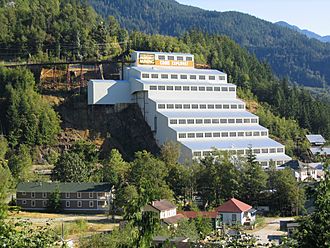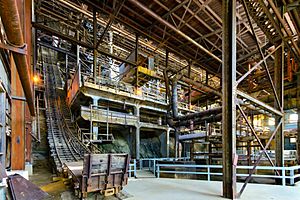Britannia Mines Concentrator facts for kids
Quick facts for kids Britannia Mines Concentrator |
|
|---|---|

The 1923 steel concentrator building at Britannia Beach.
|
|
| General information | |
| Classification | Mining |
| Town or city | Britannia Beach. British Columbia |
| Country | Canada |
| Coordinates | 49°37′21″N 123°12′14″W / 49.6226°N 123.2039°W |
| Completed | January 1923 |
| Height | 210 feet (64 m) |
| Official name: Britannia Mines Concentrator National Historic Site of Canada | |
| Designated: | 20 November 1987 |
The Britannia Mines Concentrator is a special building in Britannia Beach, British Columbia, Canada. It is known as a National Historic Site of Canada. This huge, sloped building was a "gravity mill." It helped process copper ore using chemical and mechanical steps. You can find it on the side of Mount Sheer, about 45 kilometers north of Vancouver.
The area around Britannia Beach has mountains like Mount Garibaldi. These mountains show that there's a lot of volcanic rock, which often means copper can be found there. The town and the concentrator building are located on the western shore of the Britannia Range, right next to the large ocean inlet called Howe Sound.
Mining claims were first made in the 1880s. The Britannia Beach Mining and Smelting Company started in the early 1900s. Copper mining began here in 1903. Since the ore had to travel far to be processed, a special building called an ore concentrator was needed. This building would prepare the ore for shipping.
The first concentrator, called No. 1, was built in 1904. Later, two more units, known as No. 2, were added in 1914 and 1915. Sadly, a fire in 1921 destroyed these buildings. A new, strong building made of concrete and steel was finished in early 1923. By the late 1920s, Britannia Mines was the biggest copper mine in the British Empire. It also produced silver and gold.
Today, the Britannia Mines Concentrator is owned by the Britannia Beach Historical Society. It is part of the Britannia Mine Museum, where visitors can learn about its history.
Contents
Discovering Copper Ore
In the late 1880s, people explored the area looking for gold. One of them, Dr. A. Forbes, claimed land there. But it wasn't until 1898 that trappers, including Oliver Furry (who Furry Creek is named after), found copper ore. This copper was mixed with other minerals in a type of rock called schist.
Many mining claims were made. This led to the creation of the Britannia Mining and Smelting Company. They had claims for mines at four different places: Bluff, Empress, Fairview, and Jane.
Early Mining Operations
Britannia Mines started digging for copper ore in 1903. This was done on Mount Sheer and nearby areas along the eastern shore of Howe Sound. The ore found here didn't have a lot of copper. So, it needed to be "concentrated" before being sent to a processing plant.
This meant building a concentrator. It also needed a system to move the crushed ore from the mine to the concentrator. In 1904, a gravity concentrator was built. It could process 200 tons of ore every day. The processed material, called concentrate, was about 10% copper. It was then sent to Crofton for smelting (melting to get the pure metal). The first shipment happened in December 1905.
A company called Howe Sound Company owned the Britannia Beach Mining and Smelting Company. This company also owned other mines and a smelter.
Expanding the Mine
By 1912, most of the easily found copper ore at Britannia Beach had been mined. To keep making money, the mine started digging for lower-grade ore. This meant they needed a new, bigger wooden concentrator. This new concentrator was built in two parts, in 1914 and 1915.
It used a new method called flotation. This technique had been tested in the first concentrator in 1912. An inclined railway was also built to bring ore down from the Jane Basin mine.
Between 1905 and 1915, the mine's production grew ten times bigger. This was mainly because of the First World War. There was a huge demand for copper to make shell casings and bullet jackets. Most of the copper went to the Imperial Munitions Board. To keep up, the mine kept growing, adding more equipment and hiring more workers. At its busiest, the mine had 900 workers. During this time, the ore was sent to the ASARCO smelter in Tacoma instead of Crofton.
In the winter of 1921, a fire destroyed the concentrator building. Mining stopped. Luckily, firefighters saved the hydro-electric plant nearby. This plant used a water wheel to make electricity. The company decided to build an even better concentrator. They hired engineers from San Francisco to design the new building.
Building the New Concentrator
In 1922, Britannia Mines started building a new gravity concentrator. This one could process 2,500 tons of ore every day! The huge concrete and steel building, called No. 3 Concentrator, was finished in January 1923. It was built on the northwest side of Mount Sheer.
By 1925, Britannia Mines produced more copper ore concentrate than any other mine in the British Empire. It held this record until 1930. During this time, it also produced "significant amounts of silver and gold." The old No. 1 Concentrator was taken apart.
To supply the new, large concentrator, many miles of tunnels were dug. These tunnels went high into the mountains and deep below sea level. Big fans helped with air, and electric lights, pumps, and air drills made the work easier.
Inside No. 3 Concentrator, ore was first crushed into small pieces. Then it was ground into a fine powder in large ball mills. After that, it went through special machines and flotation mills to separate the copper. Finally, the concentrate was sorted and dried. Ore concentrate is about 40 percent metal. It then needed to go to a smelter for more refining.
Britannia Beach was a "company town." This meant the mining company owned everything, even the store. Workers lived in the town and could only leave by a special boat. Highway 99, the main road, wasn't built until 1955. Working conditions were tough, and miners often faced challenges. The company became unionized in 1946, after the war.
What the Building Looks Like
The concentrator building is 20 stories tall and looks very impressive. Its windows face northwest towards Howe Sound. The building is shaped like a rectangle. It is about 209 feet (64 m) wide and 271 feet (83 m) deep at its base. Each level is between 50 to 70 feet (15 to 21 m) high. A small shed for ventilation was added to the top in 1926.
Ore entered the concentrator at its highest point, about 230 feet (70 m) from its base. It then moved down through the building by gravity. It passed through eight levels of the structure. From the very bottom level, the processed ore was piped directly into the hold of a cargo ship, ready to be sent away.
Britannia Beach continued mining until 1974.
A National Historic Site
The Britannia Mines Concentrator is now part of the Britannia Mine Museum. It is owned by the Britannia Beach Historical Society.
This large industrial building has also been used as a setting for several movies and television shows.




